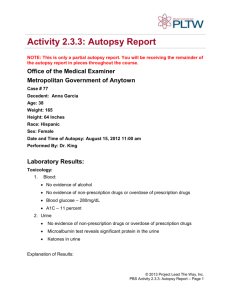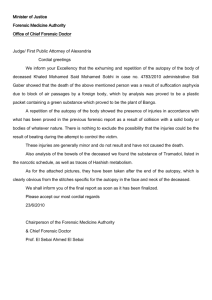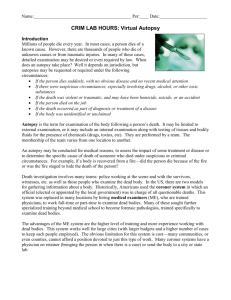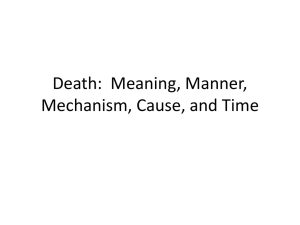Forensic Pathology
advertisement
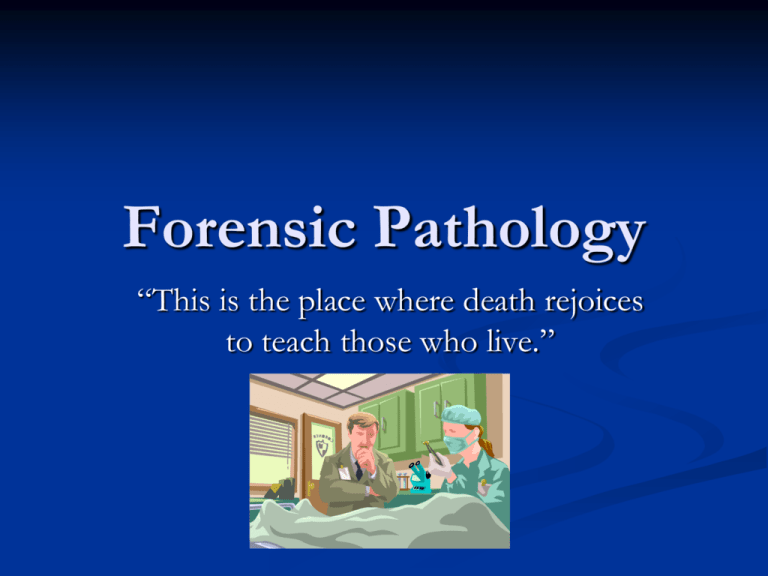
Forensic Pathology “This is the place where death rejoices to teach those who live.” Introduction A death that is unexpected or is thought to have been caused by injury or trauma is always investigated. Coroner Medical Examiner Coroner vs. Medical Examiner Coroner – a public official, appointed or elected, who makes inquires into deaths and completes death certificates. Determines cause/manner of death Decides if foul play May or may not have medical training Coroner vs. Medical Examiner Medical Examiner – a physician, evaluates medical history and physical exam of deceased to determine cause and manner of death. Must receive special training to become a forensic pathologist Forensic Pathology – unnatural or suspicious disease or injury In most large US cities, the medical examiner is required to be a forensic pathologist. Forensic Pathologist Education and Training Medical school – 4 years Post – medical training 3 to 5 year residency in general pathology Additional year of training In medical examiners office (forensic pathology) American Board of Pathology Exam Training / Knowledge in other areas of Forensics In US 500 Forensic Pathologists About 25 of the 500 also have LAW DEGREES Deaths Investigated Two Main Categories 1. Persons who die suddenly when in apparent good health, those who are unexpected to die, or those who are without medical treatment for fatal diseases. Public Health Threat (bacterial meningitus) Death in public places (electrocution in public place) Maternal Death Death outside of medical facility Deaths Investigated 2. Deaths caused by unnatural causes Examples: Acts of violence Drug related Trauma / Asphyxiation Weather Vehicular accident Deaths Investigated Special Categories: Under 18 Death of an individual under legally dependent care. Death in correctional facility On aircraft or ship MURDERS ARE THE SMALLEST NUMBER OF DEATHS INVESTIGATED! Three facets of guilt: Motive Means Opportunity Medical Examiner’s Duties: Review eyewitness statements Examine crime scene Autopsy Photography Report Testimony Duties and Responsibilities Establish the cause of death Establish the time of death Infer the type of weapon used Determine the manner of death Identify the deceased Determine the effects of trauma or pre-existing conditions. Postmortem Lividity (Livor Mortis) The Settling of blood that causes the skin to change color 30 Minutes: Changes in skin color first appear on fair-skinned persons 4 to 8 hours: The blood in capillaries settles PERMANENTLY Between 1 and 8 hours: (1) Blanching Light-colored marks made by finger pressure (2) Where a trained investigator will begin.. Why livor mortis is important Has the body been moved? Rigor Mortis The period of time that a body goes through a state of Rigidity Caused by lactic acid build-up in the body. Rigor Mortis Progression Shorter muscles – face, fingers, toes Neck Then moves down and out the long muscles of the legs and forearms Legs stiffen last Rigor MortisTime-line 1-4 hours: Jaw and neck rigid, rest of body limp Up to 8 hours: everything down to the legs is rigid For 12 hours: everything remains rigid 24 hours: Jaw is limp, everything else is rigid 30-32 hours: everything but the legs are limp 36 hours: entire body is limp (no rigidity) decomposition has begun Circumstances affecting Rigor Mortis Starvation Extreme temperatures Physical exertion Effects of fire or water (in the case of drowning) Decomposition Bacteria: Co2 is produced, abdominal swelling Blood vessels: discoloration of skin in upper abdomen marbling effect Red → darker red → purple → green Putracine – foul- smelling, nauseating odors Algor Mortis Either Liver temperature (LT) or Rectal Temperature (RT) Drop of about 2 degrees per hour Factors affecting temperature loss: Size (mass) of body Body Temperature at death Temperature of crime scene The Autopsy Examination “You've got to be the type of person who can emotionally disconnect [from] it. I mean, if you went into a case looking at it as, 'Geez, this is somebody's little girl or somebody's little boy,' you'd never be able to do the case. You can't personalize it in any way... When you walk in, you never forget that this is somebody's loved one. You never forget that, but when you walk in to do the job, you kinda put that information aside. You look at them more as a puzzle, and your job is to sort out this puzzle. I've got to find out what happened. Who, what, why, when, where. I mean, that's what my job is, to sort out and get those answers. And, do it in a respectful way. A lot of people can't do this type of job. A lot of people don't want to do this type of job. There are a lot of jobs I wouldn't want to do either.” Eric Kiesel Atlanta's Fulton County Deputy Chief Medical Examiner HISTORY OF AUTOPSY EGYPTIONS 1600 BCE HIPPOCRATES – 5TH + 4TH CENTURY BCE AUTOPSIES TO DETERMINE THE CAUSE OF DEATH: The Autopsy Examination Legality Permission required – family can request an autopsy be performed (usually free) Next of kin must sign autopsy permit. Religious considerations Mandatory when death is suspicious of foul play or if public health concern (in most states) The Autopsy Examination Attending Personnel Diener – autopsy assistant Prosector - pathologist Pathologist Assistant Precautions – protective clothing The Autopsy Examination The External Exam = done first when body is examined. Looking for: Wounds Contusions (Bruises) Unusual marks on the body Overall impression of the body Forensic Autopsy An intensive search for information To locate PHYSICAL EVIDENCE to determine the cause of death The Autopsy Examination At this point, a general description of the body is made. All identifying features are noted including: Race Sex Hair color and length Eye color Approximate age Any identifying features (scars,tattoos, etc.) The Autopsy Examination Opening the Body Y-incision: incision made from left and right shoulders to mid-chest and straight down to pubic region. No bleeding (usually) because there is no blood pressure. If head is to be opened, an incision is made across the head from one ear to the other. ----------------------------------------- The Autopsy Examination Rib cage is cut at the cartilage that joins the ribs to the breastbone with a scalpel, saw or knife to enter the chest cavity. Soft tissue peeled back to look for abnormalities. Chest plate (ribs and breastbone) are removed and examined. Often fractured during CPR. Skull is cut in front and back for removal. The Autopsy Examination Removing and Examination of the Organs Each organ is removed, photographed and weighed. Organs are usually dissected and slides prepared to look for disease or irregularities. THE HEART Checked for TRAUMA Pulmonary artery The pulmonary arteries carry blood from the heart to the lungs. They are the only arteries (other than umbilical arteries in the fetus) that carry deoxygenated blood. Looking for a blood clot that has dislodged from a vein traveling through the heart To the pulmonary artery: SUDDEN DEATH Blood samples are taken from the AORTA Blood-typing and Blood/Alcohol test Larynx and Trachea Food lodged in trachea Checked for food bolus (choking) Lungs Drowning Diatoms lungs stomach Blood stream Bone marrow Heroin Use Carbonate crystals Used to mix heroin Will be found in the lungs Death in fires If alive During Fire there Will be soot and ash in the Trachea Bronchi And Lungs If CO2 levels in blood are greater than 2% The victim was alive at the onset of the fire Samples taken CO2 and other gases in lungs Microscopic slides Liver Liver A healthy liver: Soft, pliable, vulnerable to blunt-force trauma Cirrhotic Liver Caused by hepatitus, malnutrition, drug & alcohol use Jaundiced Liver Kidneys – filter blood The “Kidney Punch” A World Boxing Association foul Drug use Drug addicts who have a cirrhotic liver cannot metabolize proteins…… Toxins pass out of the liver and Damage kidneys Diseased Kidneys Jaundiced kidneys Polycystic liver Stomach Important in drug-overdose cases Helps establish activities prior to death POISONS CYANIDE -red color of organs -almond-like odor (only 50% of pop can detect the odor) -KCN used for executions Estimated time of death If TIME OF MEAL and MENU are known Intestines Location of food can help determine time of death Pair swallows 850 g cocaine.. “Katriya Connor, 23, a chef from Waterloo in Liverpool, became violently ill on a flight from Cancun in Mexico to Birmingham on February 6, after scores of packets of cocaine that she had swallowed burst in her stomach. She died within hours on an airport runway in the Azores, where the flight had been diverted, while paramedics desperately tried to save her life. A 21-yearold man, apparently travelling with Ms Connor, also fell into a coma on the flight and remains seriously ill on the island.” (from The Guardian) Stomach of drug “mule” Drug packets in rectum area Bladder URINE SAMPLE Reproductive Organs Inspected for pregnancy (Teenage suicide) The Brain Removal of Brain A blood clot caused by a blow to the head – can be fatal Formaldehyde “fixes” the brain for better dissection Autopsy Conclusion Samples are obtained of bodily fluids and sent to toxicology for examination. Blood Urine Bile Manner and Cause of Death Mechanism – biochemical or physiological abnormality produced by the cause of death that is incompatible with life. Manner of Death – homicide, suicide, natural causes, accidental or undetermined. Cause – disease or injury that initiated the lethal chain of events that lead to death Manner of Death homicide Suicide accidental – trauma occurring from acts NO REASONABLE person would have felt have a high probability of injury or death natural cause undetermined Determination of Cause of Death One can die of a massive hemorrhage (the mechanism of death) due to a gunshot wound through the head (the cause of death) as a result of being shot (homicide), shooting yourself (suicide), dropping the gun and it discharging (accidental), or not being able to tell how it occurred (undetermined). All of which are manners of death. Causes of Death Brain Damage: Subdural hematoma Brain Damage: Subarachnoid hematoma Brain Damage: Intracerebral hematoma: Suffocation Positional Asphyxiation Positional Asphyxiation SADS Choking Drowning Vomitos amigos: Drug/alcohol Intoxication Neck Injuries Strangulation accidental suicide homicide Petechial hemorrhage Ruptures in the tiny capillaries Hyoid Bone Hanging Nature of rope and knots Suicide by hanging Male suicide Female suicide Jugular vein On average, blood accounts for 8% of total body weight 5 to 6 liters of blood for males 4 to 5 liters of blood for females A 40 percent blood loss results in death. The loss of 1.5 L can cause incapacitation. Jugular vein Stab Wounds: Sharp Force Trauma Type of knife used (width, length, single or double-edged) Stabbing wounds Slicing wounds Blunt Force Trauma Caused by being struck by a flat surface Gunshot Wounds International Gun Statistics Classification of Traumatic Death Four Categories: Thermal Chemical Electrical Mechanical Asphyxiation – interference of oxygen to brain Can be caused by all mechanisms Mechanical Trauma Blunt or Sharp Penetrating or Non-penetrating Mechanical Trauma occurs when the applied physical force exceeds tensile strength of the tissue, causing lacerations (blunt force) or incised wounds (sharp) Mechanical Trauma Sharp Force Trauma Most common cause of death = exsanguination Major arteries or the heart are damaged Blunt Force Trauma Cause contusions or lacerations Most common cause of death = significant damage to brain or internal bleeding Mechanical Trauma Firearm Injury Contact wound – blackening of skin around wound (gas “burns” skin), small in size Distant wound – circular skin defect and rim of abraded skin around the edges Exit wound is larger and more irregular than entry wound. Chemical Trauma Death that results from drugs or poisons Alcohol = most common drug that causes death Rarely kills directly, but contributes to about 50% of traumatic deaths. Other chemicals: Drugs Carbon Monoxide Cyanide / Arsenic (poisons) Thermal Trauma Exposure to excessive heat or cold Hypothermia – excessive cold Hyperthermia – excessive heat Causes death via a breakdown in the normal mechanisms that maintain body temperature. Thermal Burns – death usually occurs as a result of complications (shock; mechanism = multiple organ failure) Cause of death in fires – inhalation of CO, not burns Electrical Trauma Passage of electricity through a person Low Voltage – heart experiences ventricular fibrillation (quivering of the heart; beats faster than the body can handle) High Voltage – forces heart into tetany, a contraction that is broken when the circuit is broken. Heart generally starts again with a normal rhythm Loss of limbs or electrical burns are possible within seconds of shock.

